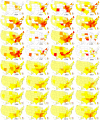Mapping the Prevalence of Physical Inactivity in U.S. States, 1984-2015
- PMID: 27959906
- PMCID: PMC5154575
- DOI: 10.1371/journal.pone.0168175
Mapping the Prevalence of Physical Inactivity in U.S. States, 1984-2015
Abstract
Background: Physical inactivity is a leading cause of morbidity, disability and premature mortality in the U.S. and worldwide. This study aimed to map the prevalence of physical inactivity across U.S. states over the past three decades, and estimate the over-time adjusted changes in the prevalence of physical inactivity in each state.
Methods: Individual-level data (N = 6,701,954) were taken from the 1984-2015 Behavioral Risk Factor Surveillance System (BRFSS), an annually repeated cross-sectional survey of state-representative adult population. Prevalence of self-reported leisure-time physical inactivity was estimated by state and survey year, accounting for the BRFSS sampling design. Logistic regressions were performed to estimate the changes in the prevalence of physical inactivity over the study period for each state, adjusting for individual characteristics including sex, age, race/ethnicity, education, marital status, and employment status.
Results: The prevalence of leisure-time physical inactivity varied substantially across states and survey years. In general, the adjusted prevalence of physical inactivity gradually declined over the past three decades in a majority of states. However, a substantial proportion of American adults remain physically inactive. Among the 50 states and District of Columbia, 45 had over a fifth of their adult population without any leisure-time physical activity, and 8 had over 30% without physical activity in 2015. Moreover, the adjusted prevalence of physical inactivity in several states (Arizona, North Carolina, North Dakota, Utah, West Virginia, and Wyoming) remained largely unchanged or even increased (Minnesota and Ohio) over the study period.
Conclusions: Although the prevalence of physical inactivity declined over the past three decades in a majority of states, the rates remain substantially high and vary considerably across states. Closely monitoring and tracking physical activity level using the state physical activity maps can help guide policy and program development to promote physical activity and reduce the burden of chronic disease.
Conflict of interest statement
The authors have declared that no competing interests exist.
Figures
References
-
- World Health Organization. Environment and health risks: A review of the influence and effects of social inequalities. http://www.euro.who.int/__data/assets/pdf_file/0003/78069/E93670.pdf.
-
- Centers for Disease Control and Prevention. Physical activity and health: a report of the Surgeon General. https://www.cdc.gov/nccdphp/sgr/.
MeSH terms
LinkOut - more resources
Full Text Sources
Other Literature Sources
Medical
Miscellaneous



